University of Debrecen Research: ASEAN Economic Integration Challenges
VerifiedAdded on 2022/11/19
|54
|14353
|1
Report
AI Summary
This research paper, focusing on the Association of Southeast Asian Nations (ASEAN), examines the benefits, challenges, and potential solutions related to regional economic integration. The study, based on secondary data and qualitative analysis, explores ASEAN's economic growth, trade practices, and the impact of government policies. The paper investigates challenges such as unstable regional relationships, inefficient business governance, and income diversity. It also explores the impact of these challenges on the growth and sustainability of the region. The research aims to identify strategies for overcoming these challenges and improving ASEAN's economic performance, offering valuable insights for businesses and academics alike. The study includes an introduction to regional economic integration, an extensive literature review, a detailed methodology section, data analysis, and findings, leading to conclusions and recommendations for future research.
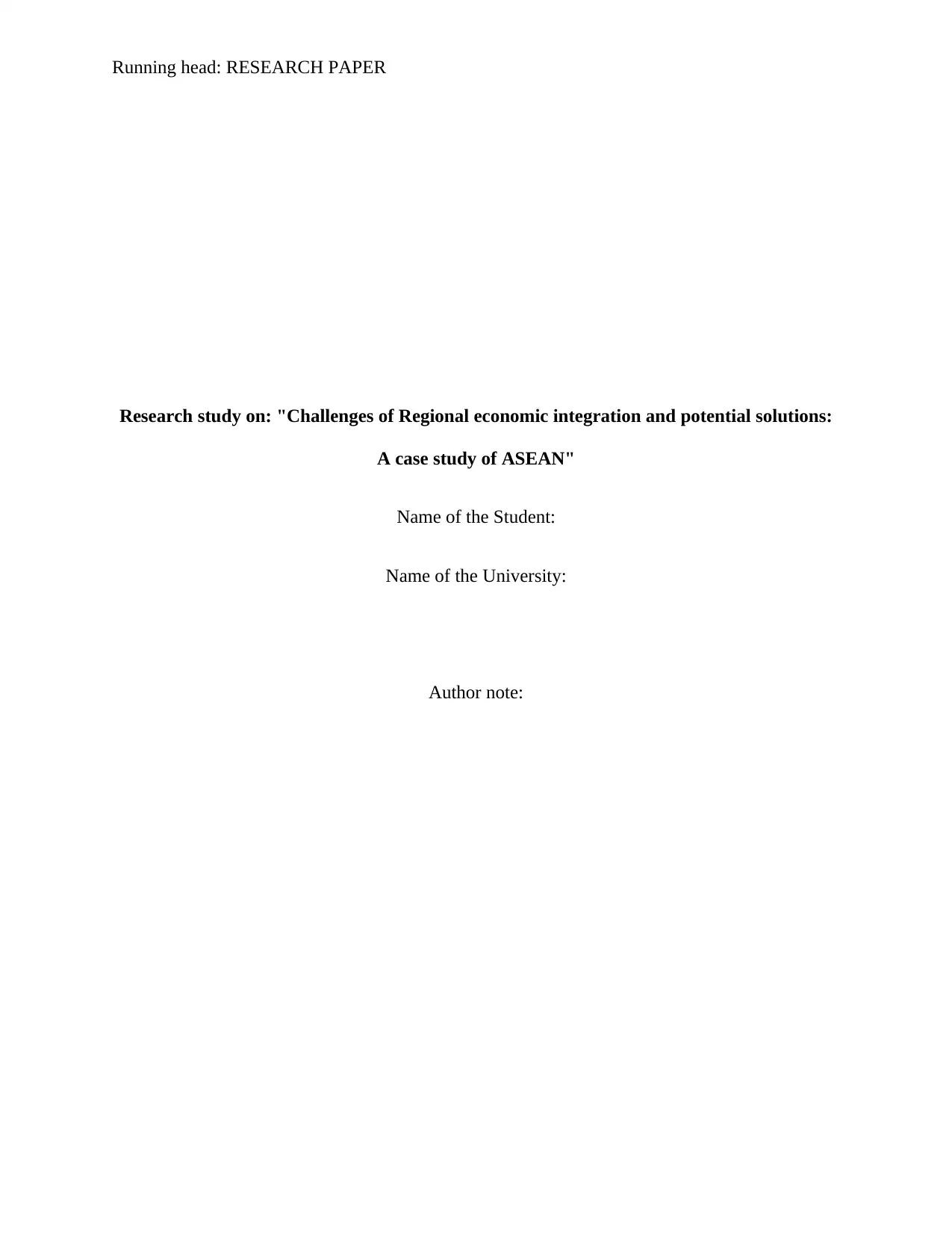
Running head: RESEARCH PAPER
Research study on: "Challenges of Regional economic integration and potential solutions:
A case study of ASEAN"
Name of the Student:
Name of the University:
Author note:
Research study on: "Challenges of Regional economic integration and potential solutions:
A case study of ASEAN"
Name of the Student:
Name of the University:
Author note:
Paraphrase This Document
Need a fresh take? Get an instant paraphrase of this document with our AI Paraphraser

1RESEARCH PAPER
Acknowledgement
I am thankful to all the people for their guidance and thorough support that made it possible for
me to perform this research work. Their support and belief had made me realize my true strength
and potential. This has made me implement all my qualities in the research study in its best
possible manner. Firstly, I would like to thank my guide for his continuous and uninterrupted
guidance. This has contributed to my prominent knowledge and helped me in completing my
work on time. Additionally I would also like to appreciate the unconditional devotion that he has
conferred upon my work and me. This has kept me grounded and made my personality better.
Moreover, I would also like to express my gratitude towards all the participants who devoted
their valuable time in my study. Lastly, I would express my appreciation for my family and
friends who supported me throughout and encouraged my ability to complete the research work
successfully.
Acknowledgement
I am thankful to all the people for their guidance and thorough support that made it possible for
me to perform this research work. Their support and belief had made me realize my true strength
and potential. This has made me implement all my qualities in the research study in its best
possible manner. Firstly, I would like to thank my guide for his continuous and uninterrupted
guidance. This has contributed to my prominent knowledge and helped me in completing my
work on time. Additionally I would also like to appreciate the unconditional devotion that he has
conferred upon my work and me. This has kept me grounded and made my personality better.
Moreover, I would also like to express my gratitude towards all the participants who devoted
their valuable time in my study. Lastly, I would express my appreciation for my family and
friends who supported me throughout and encouraged my ability to complete the research work
successfully.
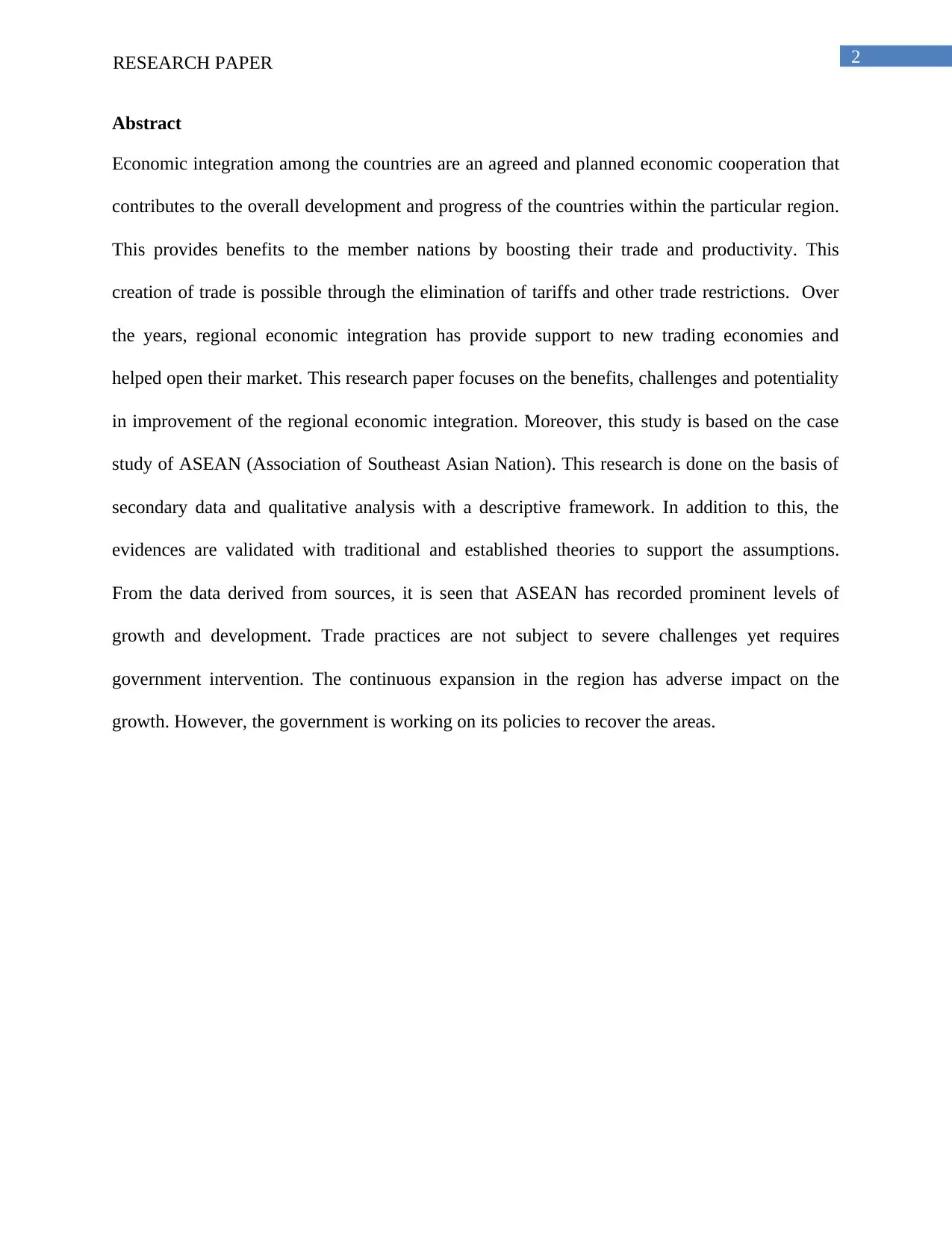
2RESEARCH PAPER
Abstract
Economic integration among the countries are an agreed and planned economic cooperation that
contributes to the overall development and progress of the countries within the particular region.
This provides benefits to the member nations by boosting their trade and productivity. This
creation of trade is possible through the elimination of tariffs and other trade restrictions. Over
the years, regional economic integration has provide support to new trading economies and
helped open their market. This research paper focuses on the benefits, challenges and potentiality
in improvement of the regional economic integration. Moreover, this study is based on the case
study of ASEAN (Association of Southeast Asian Nation). This research is done on the basis of
secondary data and qualitative analysis with a descriptive framework. In addition to this, the
evidences are validated with traditional and established theories to support the assumptions.
From the data derived from sources, it is seen that ASEAN has recorded prominent levels of
growth and development. Trade practices are not subject to severe challenges yet requires
government intervention. The continuous expansion in the region has adverse impact on the
growth. However, the government is working on its policies to recover the areas.
Abstract
Economic integration among the countries are an agreed and planned economic cooperation that
contributes to the overall development and progress of the countries within the particular region.
This provides benefits to the member nations by boosting their trade and productivity. This
creation of trade is possible through the elimination of tariffs and other trade restrictions. Over
the years, regional economic integration has provide support to new trading economies and
helped open their market. This research paper focuses on the benefits, challenges and potentiality
in improvement of the regional economic integration. Moreover, this study is based on the case
study of ASEAN (Association of Southeast Asian Nation). This research is done on the basis of
secondary data and qualitative analysis with a descriptive framework. In addition to this, the
evidences are validated with traditional and established theories to support the assumptions.
From the data derived from sources, it is seen that ASEAN has recorded prominent levels of
growth and development. Trade practices are not subject to severe challenges yet requires
government intervention. The continuous expansion in the region has adverse impact on the
growth. However, the government is working on its policies to recover the areas.
⊘ This is a preview!⊘
Do you want full access?
Subscribe today to unlock all pages.

Trusted by 1+ million students worldwide
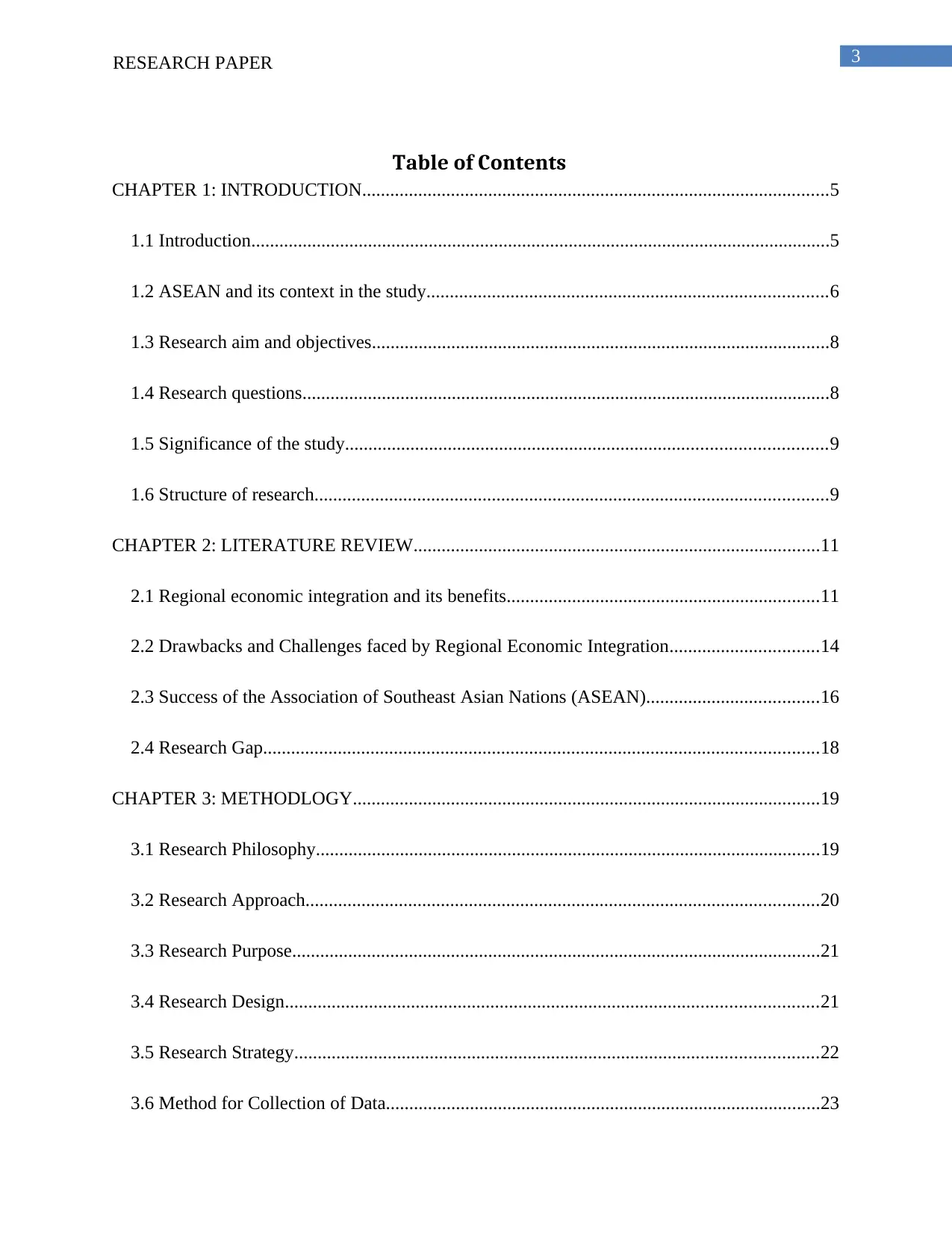
3RESEARCH PAPER
Table of Contents
CHAPTER 1: INTRODUCTION....................................................................................................5
1.1 Introduction............................................................................................................................5
1.2 ASEAN and its context in the study......................................................................................6
1.3 Research aim and objectives..................................................................................................8
1.4 Research questions.................................................................................................................8
1.5 Significance of the study.......................................................................................................9
1.6 Structure of research..............................................................................................................9
CHAPTER 2: LITERATURE REVIEW.......................................................................................11
2.1 Regional economic integration and its benefits...................................................................11
2.2 Drawbacks and Challenges faced by Regional Economic Integration................................14
2.3 Success of the Association of Southeast Asian Nations (ASEAN).....................................16
2.4 Research Gap.......................................................................................................................18
CHAPTER 3: METHODLOGY....................................................................................................19
3.1 Research Philosophy............................................................................................................19
3.2 Research Approach..............................................................................................................20
3.3 Research Purpose.................................................................................................................21
3.4 Research Design..................................................................................................................21
3.5 Research Strategy................................................................................................................22
3.6 Method for Collection of Data.............................................................................................23
Table of Contents
CHAPTER 1: INTRODUCTION....................................................................................................5
1.1 Introduction............................................................................................................................5
1.2 ASEAN and its context in the study......................................................................................6
1.3 Research aim and objectives..................................................................................................8
1.4 Research questions.................................................................................................................8
1.5 Significance of the study.......................................................................................................9
1.6 Structure of research..............................................................................................................9
CHAPTER 2: LITERATURE REVIEW.......................................................................................11
2.1 Regional economic integration and its benefits...................................................................11
2.2 Drawbacks and Challenges faced by Regional Economic Integration................................14
2.3 Success of the Association of Southeast Asian Nations (ASEAN).....................................16
2.4 Research Gap.......................................................................................................................18
CHAPTER 3: METHODLOGY....................................................................................................19
3.1 Research Philosophy............................................................................................................19
3.2 Research Approach..............................................................................................................20
3.3 Research Purpose.................................................................................................................21
3.4 Research Design..................................................................................................................21
3.5 Research Strategy................................................................................................................22
3.6 Method for Collection of Data.............................................................................................23
Paraphrase This Document
Need a fresh take? Get an instant paraphrase of this document with our AI Paraphraser
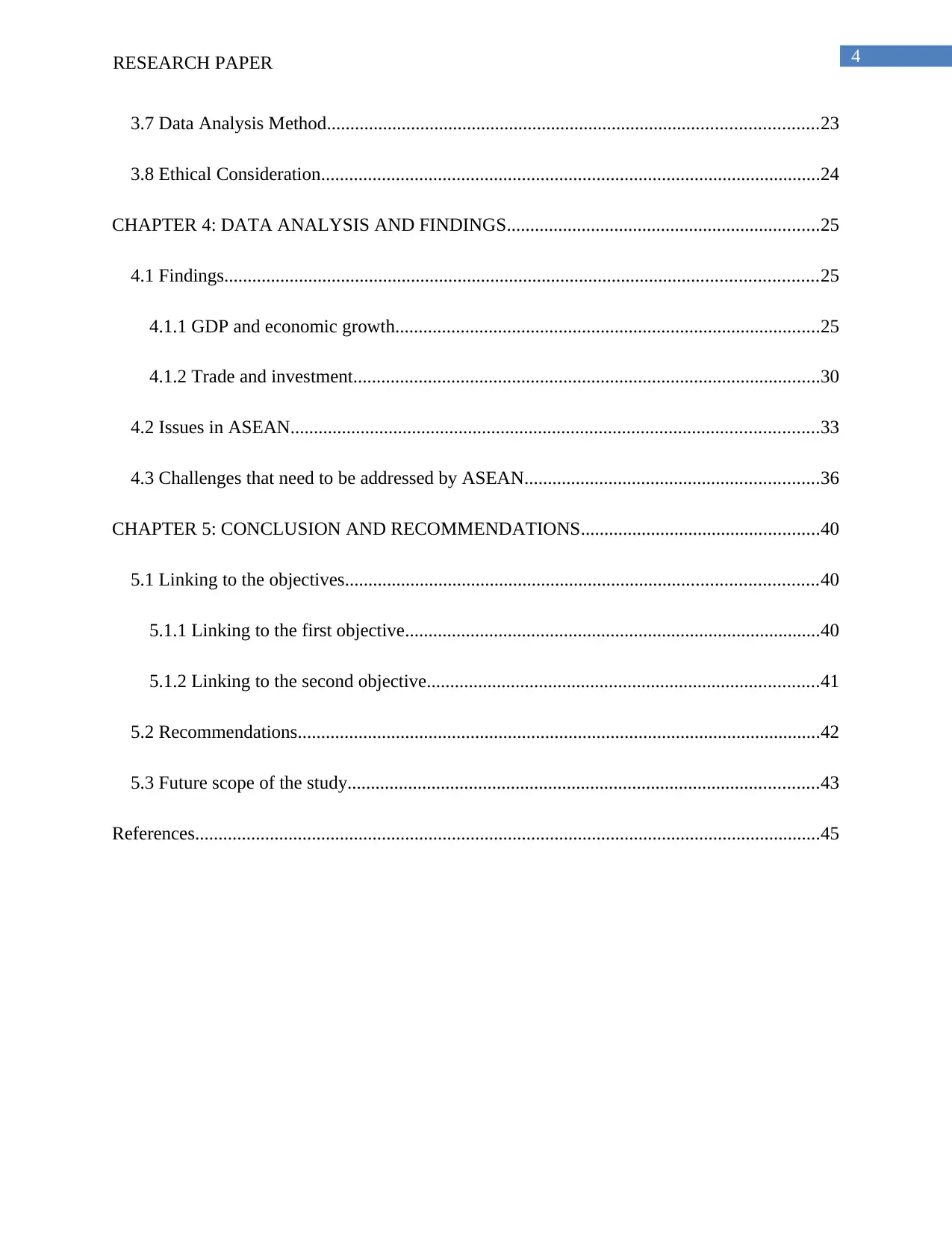
4RESEARCH PAPER
3.7 Data Analysis Method.........................................................................................................23
3.8 Ethical Consideration...........................................................................................................24
CHAPTER 4: DATA ANALYSIS AND FINDINGS...................................................................25
4.1 Findings...............................................................................................................................25
4.1.1 GDP and economic growth...........................................................................................25
4.1.2 Trade and investment....................................................................................................30
4.2 Issues in ASEAN.................................................................................................................33
4.3 Challenges that need to be addressed by ASEAN...............................................................36
CHAPTER 5: CONCLUSION AND RECOMMENDATIONS...................................................40
5.1 Linking to the objectives.....................................................................................................40
5.1.1 Linking to the first objective.........................................................................................40
5.1.2 Linking to the second objective....................................................................................41
5.2 Recommendations................................................................................................................42
5.3 Future scope of the study.....................................................................................................43
References......................................................................................................................................45
3.7 Data Analysis Method.........................................................................................................23
3.8 Ethical Consideration...........................................................................................................24
CHAPTER 4: DATA ANALYSIS AND FINDINGS...................................................................25
4.1 Findings...............................................................................................................................25
4.1.1 GDP and economic growth...........................................................................................25
4.1.2 Trade and investment....................................................................................................30
4.2 Issues in ASEAN.................................................................................................................33
4.3 Challenges that need to be addressed by ASEAN...............................................................36
CHAPTER 5: CONCLUSION AND RECOMMENDATIONS...................................................40
5.1 Linking to the objectives.....................................................................................................40
5.1.1 Linking to the first objective.........................................................................................40
5.1.2 Linking to the second objective....................................................................................41
5.2 Recommendations................................................................................................................42
5.3 Future scope of the study.....................................................................................................43
References......................................................................................................................................45
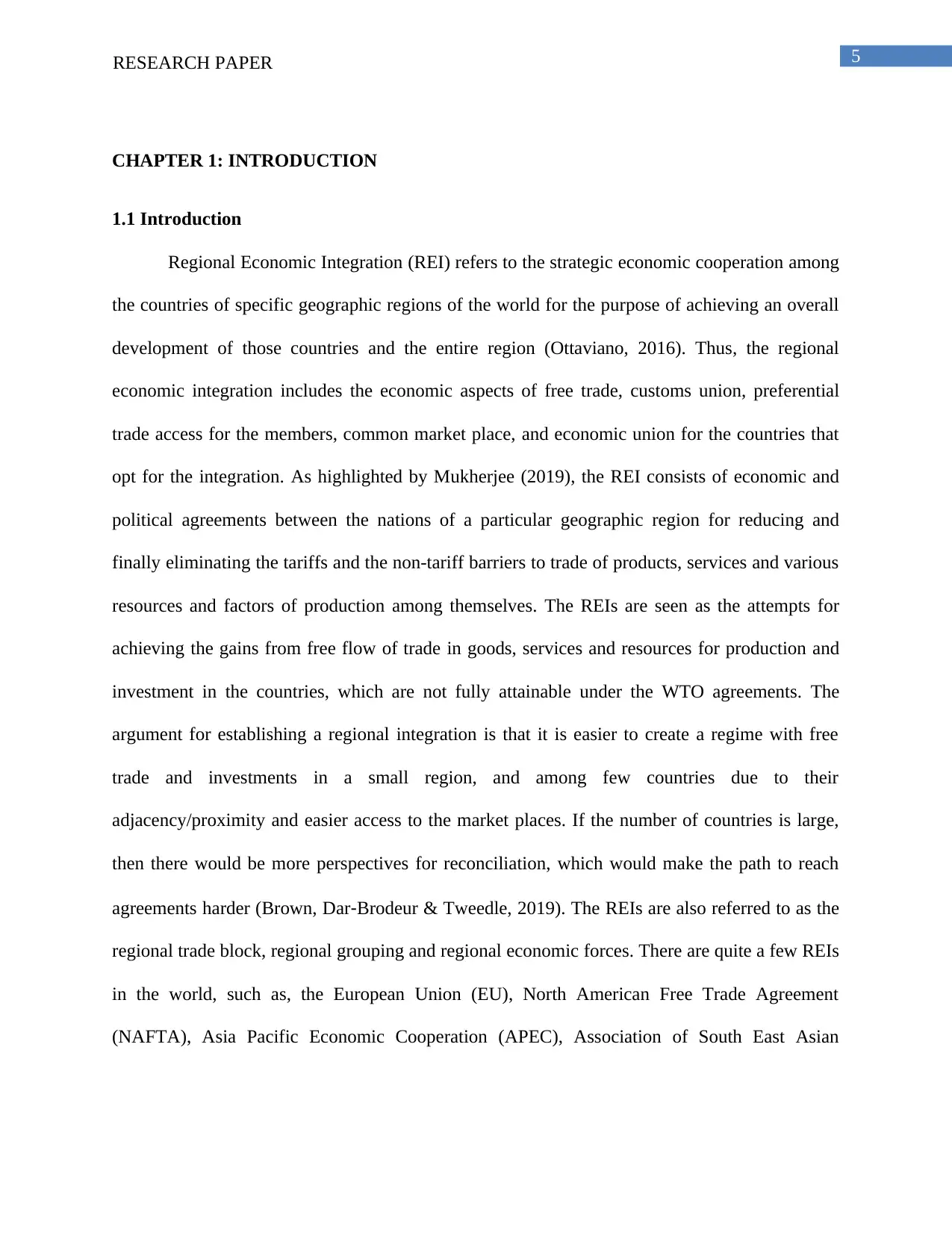
5RESEARCH PAPER
CHAPTER 1: INTRODUCTION
1.1 Introduction
Regional Economic Integration (REI) refers to the strategic economic cooperation among
the countries of specific geographic regions of the world for the purpose of achieving an overall
development of those countries and the entire region (Ottaviano, 2016). Thus, the regional
economic integration includes the economic aspects of free trade, customs union, preferential
trade access for the members, common market place, and economic union for the countries that
opt for the integration. As highlighted by Mukherjee (2019), the REI consists of economic and
political agreements between the nations of a particular geographic region for reducing and
finally eliminating the tariffs and the non-tariff barriers to trade of products, services and various
resources and factors of production among themselves. The REIs are seen as the attempts for
achieving the gains from free flow of trade in goods, services and resources for production and
investment in the countries, which are not fully attainable under the WTO agreements. The
argument for establishing a regional integration is that it is easier to create a regime with free
trade and investments in a small region, and among few countries due to their
adjacency/proximity and easier access to the market places. If the number of countries is large,
then there would be more perspectives for reconciliation, which would make the path to reach
agreements harder (Brown, Dar‐Brodeur & Tweedle, 2019). The REIs are also referred to as the
regional trade block, regional grouping and regional economic forces. There are quite a few REIs
in the world, such as, the European Union (EU), North American Free Trade Agreement
(NAFTA), Asia Pacific Economic Cooperation (APEC), Association of South East Asian
CHAPTER 1: INTRODUCTION
1.1 Introduction
Regional Economic Integration (REI) refers to the strategic economic cooperation among
the countries of specific geographic regions of the world for the purpose of achieving an overall
development of those countries and the entire region (Ottaviano, 2016). Thus, the regional
economic integration includes the economic aspects of free trade, customs union, preferential
trade access for the members, common market place, and economic union for the countries that
opt for the integration. As highlighted by Mukherjee (2019), the REI consists of economic and
political agreements between the nations of a particular geographic region for reducing and
finally eliminating the tariffs and the non-tariff barriers to trade of products, services and various
resources and factors of production among themselves. The REIs are seen as the attempts for
achieving the gains from free flow of trade in goods, services and resources for production and
investment in the countries, which are not fully attainable under the WTO agreements. The
argument for establishing a regional integration is that it is easier to create a regime with free
trade and investments in a small region, and among few countries due to their
adjacency/proximity and easier access to the market places. If the number of countries is large,
then there would be more perspectives for reconciliation, which would make the path to reach
agreements harder (Brown, Dar‐Brodeur & Tweedle, 2019). The REIs are also referred to as the
regional trade block, regional grouping and regional economic forces. There are quite a few REIs
in the world, such as, the European Union (EU), North American Free Trade Agreement
(NAFTA), Asia Pacific Economic Cooperation (APEC), Association of South East Asian
⊘ This is a preview!⊘
Do you want full access?
Subscribe today to unlock all pages.

Trusted by 1+ million students worldwide
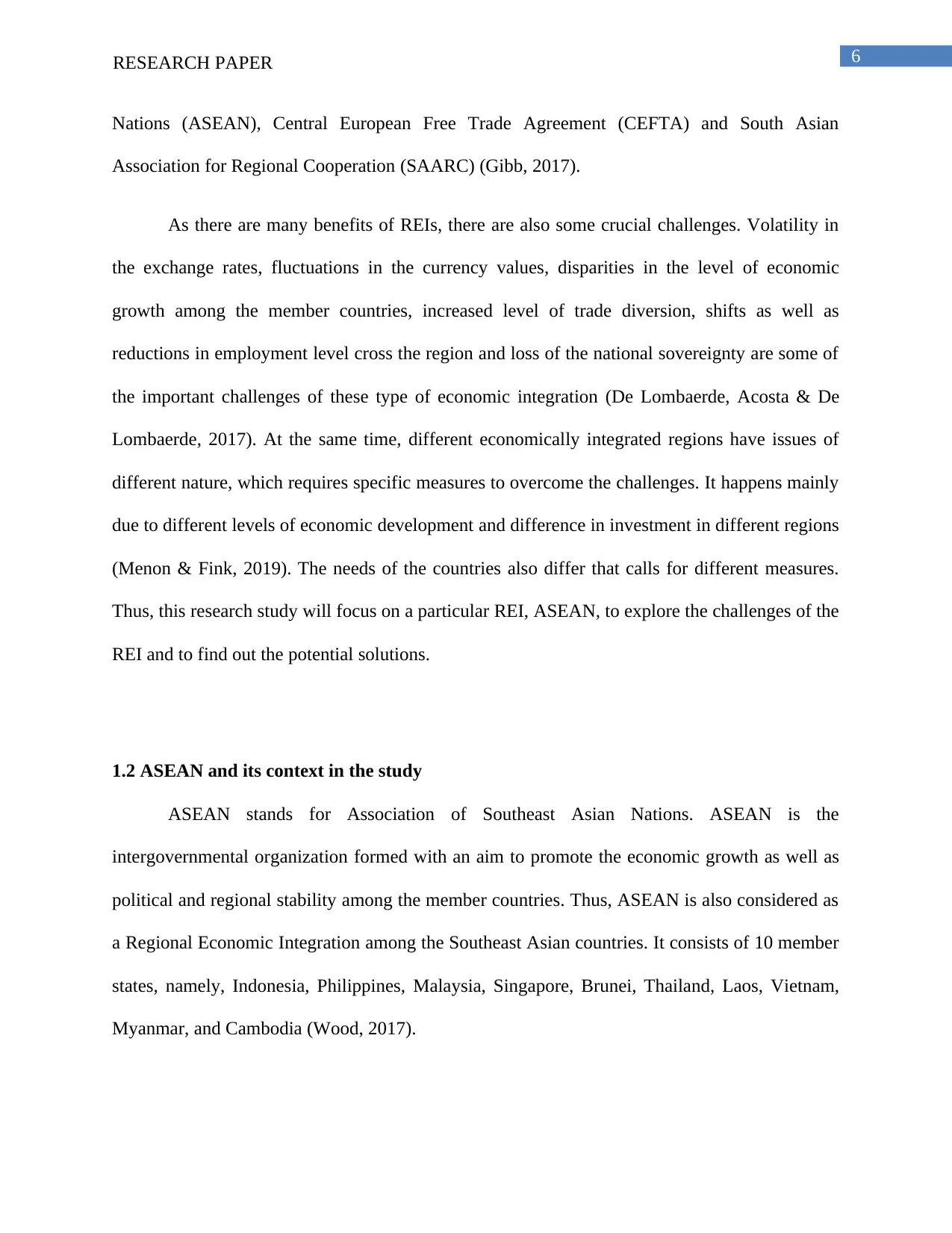
6RESEARCH PAPER
Nations (ASEAN), Central European Free Trade Agreement (CEFTA) and South Asian
Association for Regional Cooperation (SAARC) (Gibb, 2017).
As there are many benefits of REIs, there are also some crucial challenges. Volatility in
the exchange rates, fluctuations in the currency values, disparities in the level of economic
growth among the member countries, increased level of trade diversion, shifts as well as
reductions in employment level cross the region and loss of the national sovereignty are some of
the important challenges of these type of economic integration (De Lombaerde, Acosta & De
Lombaerde, 2017). At the same time, different economically integrated regions have issues of
different nature, which requires specific measures to overcome the challenges. It happens mainly
due to different levels of economic development and difference in investment in different regions
(Menon & Fink, 2019). The needs of the countries also differ that calls for different measures.
Thus, this research study will focus on a particular REI, ASEAN, to explore the challenges of the
REI and to find out the potential solutions.
1.2 ASEAN and its context in the study
ASEAN stands for Association of Southeast Asian Nations. ASEAN is the
intergovernmental organization formed with an aim to promote the economic growth as well as
political and regional stability among the member countries. Thus, ASEAN is also considered as
a Regional Economic Integration among the Southeast Asian countries. It consists of 10 member
states, namely, Indonesia, Philippines, Malaysia, Singapore, Brunei, Thailand, Laos, Vietnam,
Myanmar, and Cambodia (Wood, 2017).
Nations (ASEAN), Central European Free Trade Agreement (CEFTA) and South Asian
Association for Regional Cooperation (SAARC) (Gibb, 2017).
As there are many benefits of REIs, there are also some crucial challenges. Volatility in
the exchange rates, fluctuations in the currency values, disparities in the level of economic
growth among the member countries, increased level of trade diversion, shifts as well as
reductions in employment level cross the region and loss of the national sovereignty are some of
the important challenges of these type of economic integration (De Lombaerde, Acosta & De
Lombaerde, 2017). At the same time, different economically integrated regions have issues of
different nature, which requires specific measures to overcome the challenges. It happens mainly
due to different levels of economic development and difference in investment in different regions
(Menon & Fink, 2019). The needs of the countries also differ that calls for different measures.
Thus, this research study will focus on a particular REI, ASEAN, to explore the challenges of the
REI and to find out the potential solutions.
1.2 ASEAN and its context in the study
ASEAN stands for Association of Southeast Asian Nations. ASEAN is the
intergovernmental organization formed with an aim to promote the economic growth as well as
political and regional stability among the member countries. Thus, ASEAN is also considered as
a Regional Economic Integration among the Southeast Asian countries. It consists of 10 member
states, namely, Indonesia, Philippines, Malaysia, Singapore, Brunei, Thailand, Laos, Vietnam,
Myanmar, and Cambodia (Wood, 2017).
Paraphrase This Document
Need a fresh take? Get an instant paraphrase of this document with our AI Paraphraser
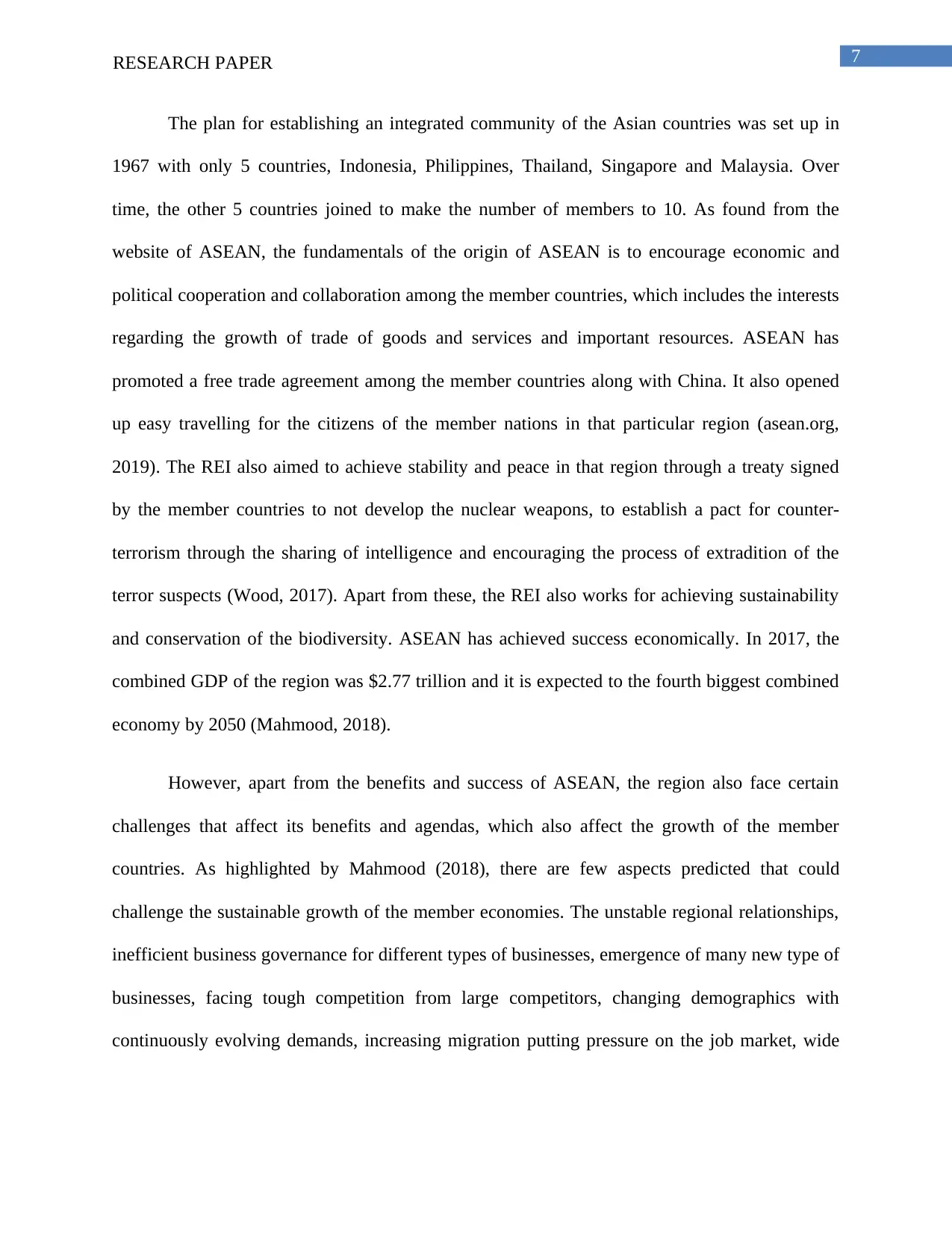
7RESEARCH PAPER
The plan for establishing an integrated community of the Asian countries was set up in
1967 with only 5 countries, Indonesia, Philippines, Thailand, Singapore and Malaysia. Over
time, the other 5 countries joined to make the number of members to 10. As found from the
website of ASEAN, the fundamentals of the origin of ASEAN is to encourage economic and
political cooperation and collaboration among the member countries, which includes the interests
regarding the growth of trade of goods and services and important resources. ASEAN has
promoted a free trade agreement among the member countries along with China. It also opened
up easy travelling for the citizens of the member nations in that particular region (asean.org,
2019). The REI also aimed to achieve stability and peace in that region through a treaty signed
by the member countries to not develop the nuclear weapons, to establish a pact for counter-
terrorism through the sharing of intelligence and encouraging the process of extradition of the
terror suspects (Wood, 2017). Apart from these, the REI also works for achieving sustainability
and conservation of the biodiversity. ASEAN has achieved success economically. In 2017, the
combined GDP of the region was $2.77 trillion and it is expected to the fourth biggest combined
economy by 2050 (Mahmood, 2018).
However, apart from the benefits and success of ASEAN, the region also face certain
challenges that affect its benefits and agendas, which also affect the growth of the member
countries. As highlighted by Mahmood (2018), there are few aspects predicted that could
challenge the sustainable growth of the member economies. The unstable regional relationships,
inefficient business governance for different types of businesses, emergence of many new type of
businesses, facing tough competition from large competitors, changing demographics with
continuously evolving demands, increasing migration putting pressure on the job market, wide
The plan for establishing an integrated community of the Asian countries was set up in
1967 with only 5 countries, Indonesia, Philippines, Thailand, Singapore and Malaysia. Over
time, the other 5 countries joined to make the number of members to 10. As found from the
website of ASEAN, the fundamentals of the origin of ASEAN is to encourage economic and
political cooperation and collaboration among the member countries, which includes the interests
regarding the growth of trade of goods and services and important resources. ASEAN has
promoted a free trade agreement among the member countries along with China. It also opened
up easy travelling for the citizens of the member nations in that particular region (asean.org,
2019). The REI also aimed to achieve stability and peace in that region through a treaty signed
by the member countries to not develop the nuclear weapons, to establish a pact for counter-
terrorism through the sharing of intelligence and encouraging the process of extradition of the
terror suspects (Wood, 2017). Apart from these, the REI also works for achieving sustainability
and conservation of the biodiversity. ASEAN has achieved success economically. In 2017, the
combined GDP of the region was $2.77 trillion and it is expected to the fourth biggest combined
economy by 2050 (Mahmood, 2018).
However, apart from the benefits and success of ASEAN, the region also face certain
challenges that affect its benefits and agendas, which also affect the growth of the member
countries. As highlighted by Mahmood (2018), there are few aspects predicted that could
challenge the sustainable growth of the member economies. The unstable regional relationships,
inefficient business governance for different types of businesses, emergence of many new type of
businesses, facing tough competition from large competitors, changing demographics with
continuously evolving demands, increasing migration putting pressure on the job market, wide
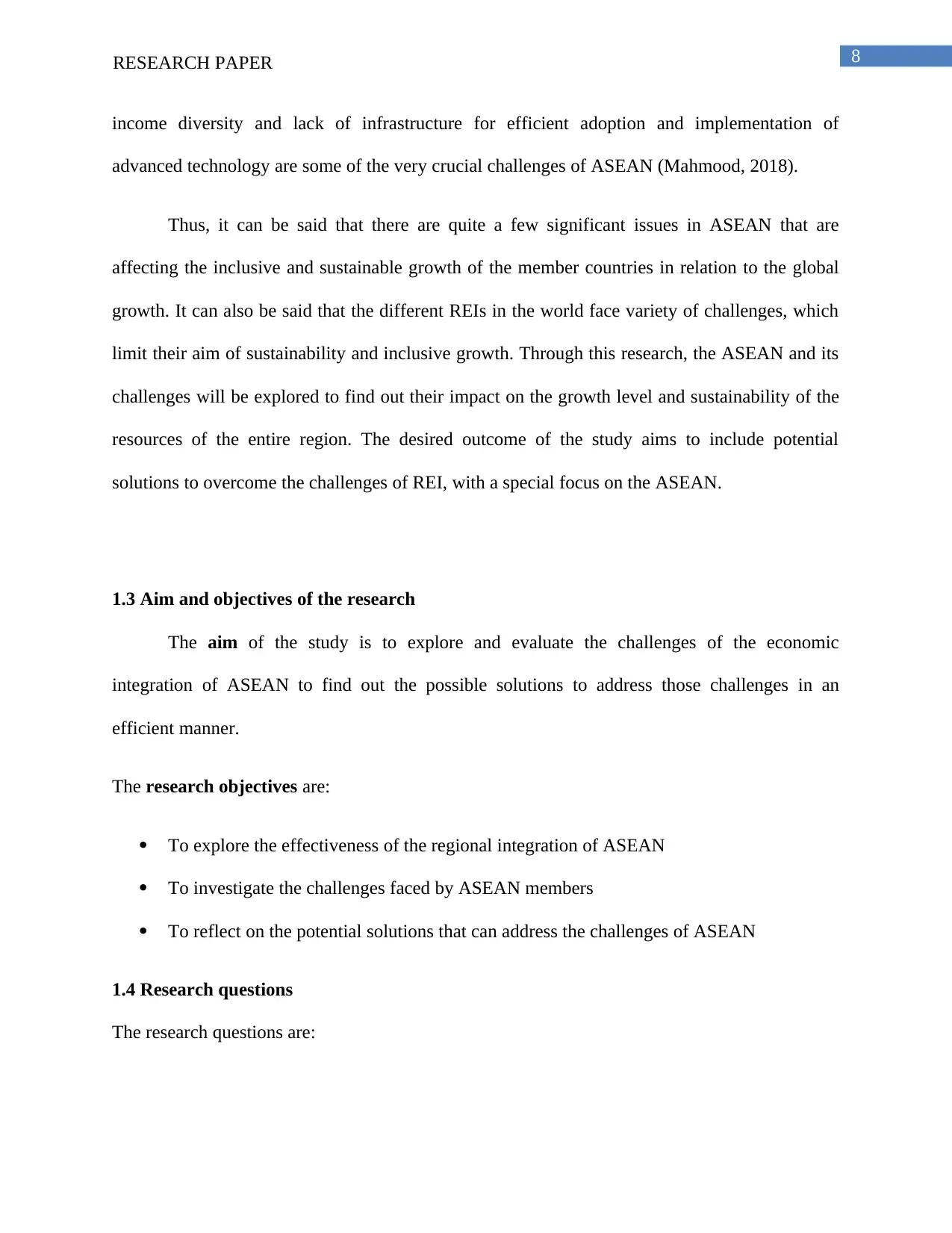
8RESEARCH PAPER
income diversity and lack of infrastructure for efficient adoption and implementation of
advanced technology are some of the very crucial challenges of ASEAN (Mahmood, 2018).
Thus, it can be said that there are quite a few significant issues in ASEAN that are
affecting the inclusive and sustainable growth of the member countries in relation to the global
growth. It can also be said that the different REIs in the world face variety of challenges, which
limit their aim of sustainability and inclusive growth. Through this research, the ASEAN and its
challenges will be explored to find out their impact on the growth level and sustainability of the
resources of the entire region. The desired outcome of the study aims to include potential
solutions to overcome the challenges of REI, with a special focus on the ASEAN.
1.3 Aim and objectives of the research
The aim of the study is to explore and evaluate the challenges of the economic
integration of ASEAN to find out the possible solutions to address those challenges in an
efficient manner.
The research objectives are:
To explore the effectiveness of the regional integration of ASEAN
To investigate the challenges faced by ASEAN members
To reflect on the potential solutions that can address the challenges of ASEAN
1.4 Research questions
The research questions are:
income diversity and lack of infrastructure for efficient adoption and implementation of
advanced technology are some of the very crucial challenges of ASEAN (Mahmood, 2018).
Thus, it can be said that there are quite a few significant issues in ASEAN that are
affecting the inclusive and sustainable growth of the member countries in relation to the global
growth. It can also be said that the different REIs in the world face variety of challenges, which
limit their aim of sustainability and inclusive growth. Through this research, the ASEAN and its
challenges will be explored to find out their impact on the growth level and sustainability of the
resources of the entire region. The desired outcome of the study aims to include potential
solutions to overcome the challenges of REI, with a special focus on the ASEAN.
1.3 Aim and objectives of the research
The aim of the study is to explore and evaluate the challenges of the economic
integration of ASEAN to find out the possible solutions to address those challenges in an
efficient manner.
The research objectives are:
To explore the effectiveness of the regional integration of ASEAN
To investigate the challenges faced by ASEAN members
To reflect on the potential solutions that can address the challenges of ASEAN
1.4 Research questions
The research questions are:
⊘ This is a preview!⊘
Do you want full access?
Subscribe today to unlock all pages.

Trusted by 1+ million students worldwide
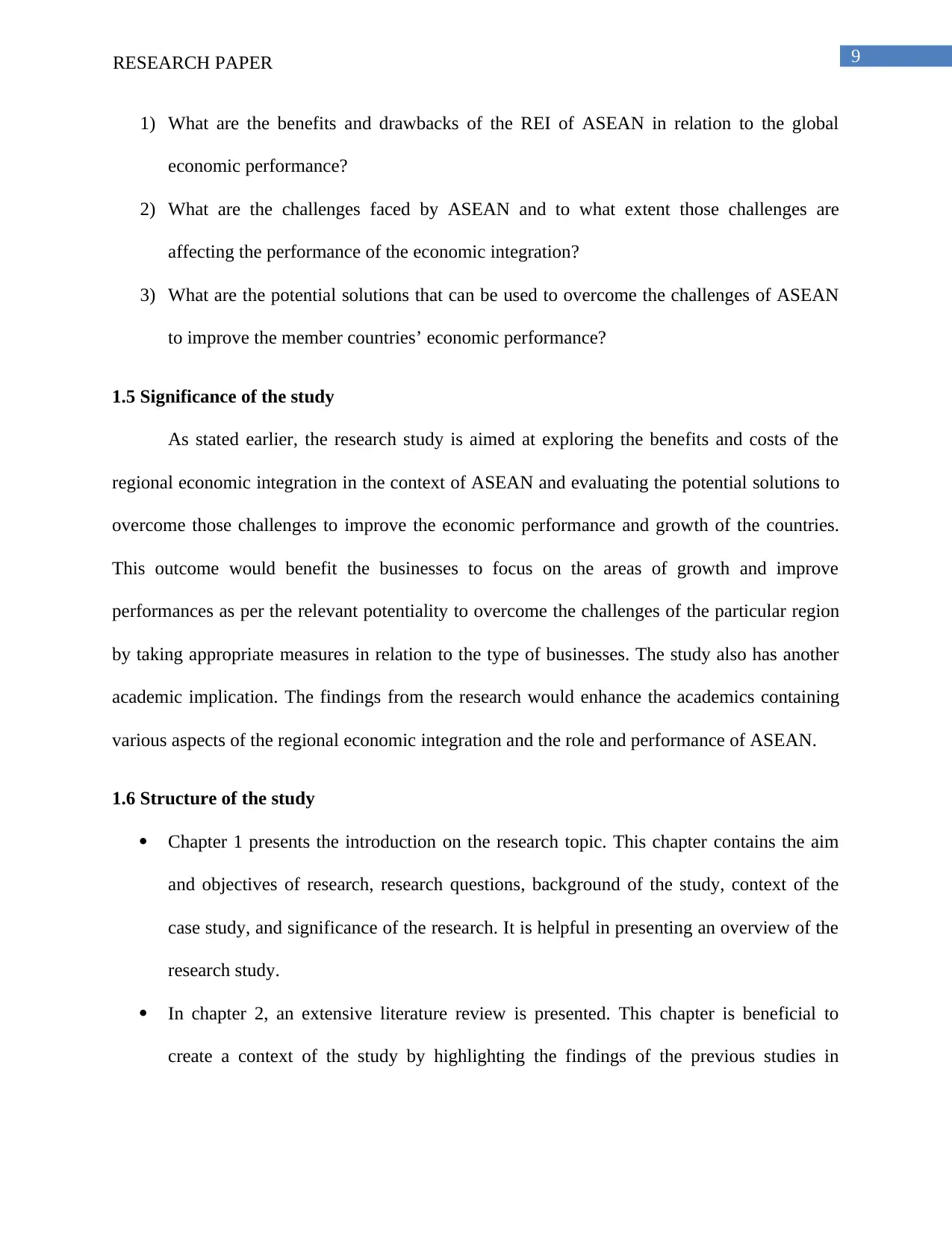
9RESEARCH PAPER
1) What are the benefits and drawbacks of the REI of ASEAN in relation to the global
economic performance?
2) What are the challenges faced by ASEAN and to what extent those challenges are
affecting the performance of the economic integration?
3) What are the potential solutions that can be used to overcome the challenges of ASEAN
to improve the member countries’ economic performance?
1.5 Significance of the study
As stated earlier, the research study is aimed at exploring the benefits and costs of the
regional economic integration in the context of ASEAN and evaluating the potential solutions to
overcome those challenges to improve the economic performance and growth of the countries.
This outcome would benefit the businesses to focus on the areas of growth and improve
performances as per the relevant potentiality to overcome the challenges of the particular region
by taking appropriate measures in relation to the type of businesses. The study also has another
academic implication. The findings from the research would enhance the academics containing
various aspects of the regional economic integration and the role and performance of ASEAN.
1.6 Structure of the study
Chapter 1 presents the introduction on the research topic. This chapter contains the aim
and objectives of research, research questions, background of the study, context of the
case study, and significance of the research. It is helpful in presenting an overview of the
research study.
In chapter 2, an extensive literature review is presented. This chapter is beneficial to
create a context of the study by highlighting the findings of the previous studies in
1) What are the benefits and drawbacks of the REI of ASEAN in relation to the global
economic performance?
2) What are the challenges faced by ASEAN and to what extent those challenges are
affecting the performance of the economic integration?
3) What are the potential solutions that can be used to overcome the challenges of ASEAN
to improve the member countries’ economic performance?
1.5 Significance of the study
As stated earlier, the research study is aimed at exploring the benefits and costs of the
regional economic integration in the context of ASEAN and evaluating the potential solutions to
overcome those challenges to improve the economic performance and growth of the countries.
This outcome would benefit the businesses to focus on the areas of growth and improve
performances as per the relevant potentiality to overcome the challenges of the particular region
by taking appropriate measures in relation to the type of businesses. The study also has another
academic implication. The findings from the research would enhance the academics containing
various aspects of the regional economic integration and the role and performance of ASEAN.
1.6 Structure of the study
Chapter 1 presents the introduction on the research topic. This chapter contains the aim
and objectives of research, research questions, background of the study, context of the
case study, and significance of the research. It is helpful in presenting an overview of the
research study.
In chapter 2, an extensive literature review is presented. This chapter is beneficial to
create a context of the study by highlighting the findings of the previous studies in
Paraphrase This Document
Need a fresh take? Get an instant paraphrase of this document with our AI Paraphraser
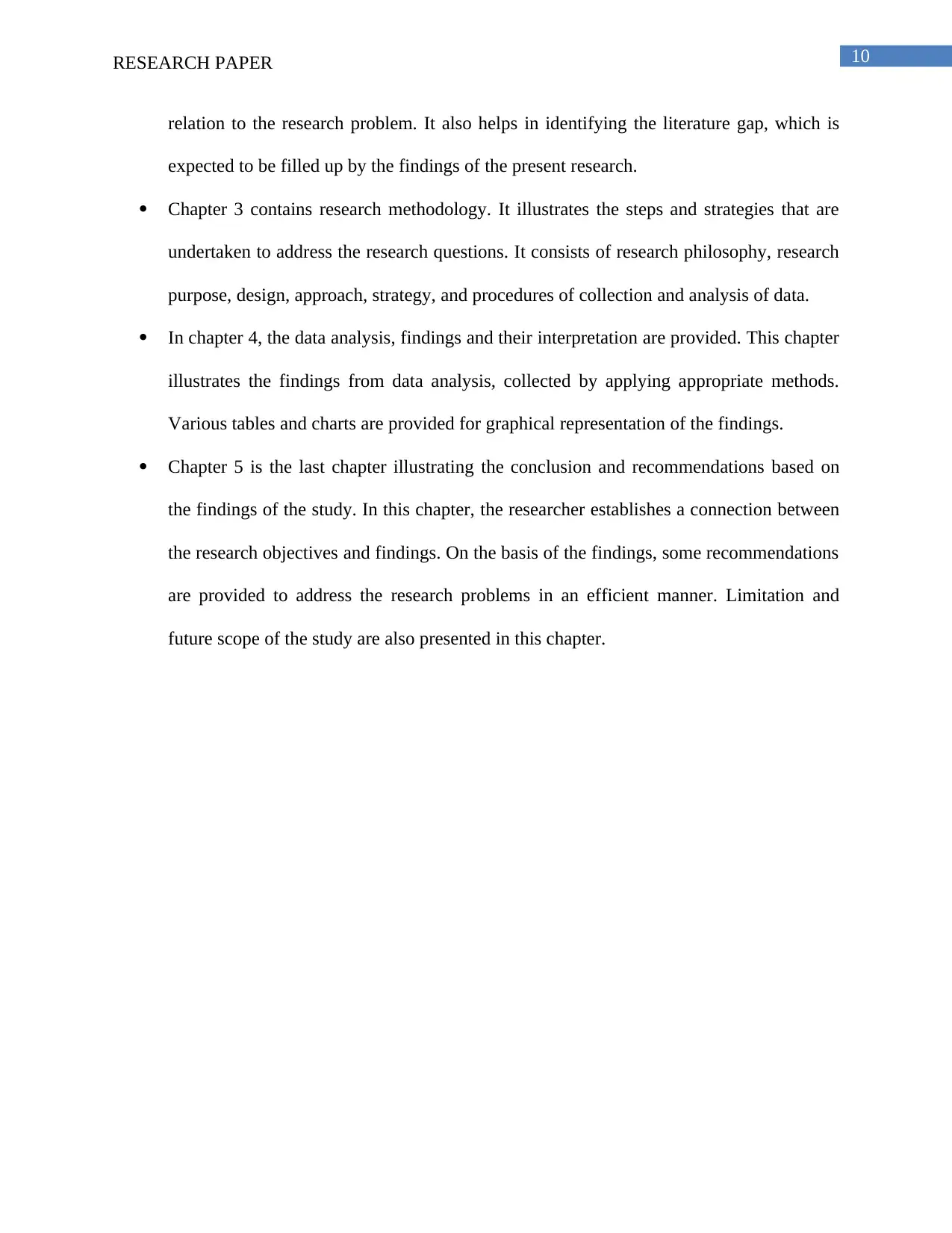
10RESEARCH PAPER
relation to the research problem. It also helps in identifying the literature gap, which is
expected to be filled up by the findings of the present research.
Chapter 3 contains research methodology. It illustrates the steps and strategies that are
undertaken to address the research questions. It consists of research philosophy, research
purpose, design, approach, strategy, and procedures of collection and analysis of data.
In chapter 4, the data analysis, findings and their interpretation are provided. This chapter
illustrates the findings from data analysis, collected by applying appropriate methods.
Various tables and charts are provided for graphical representation of the findings.
Chapter 5 is the last chapter illustrating the conclusion and recommendations based on
the findings of the study. In this chapter, the researcher establishes a connection between
the research objectives and findings. On the basis of the findings, some recommendations
are provided to address the research problems in an efficient manner. Limitation and
future scope of the study are also presented in this chapter.
relation to the research problem. It also helps in identifying the literature gap, which is
expected to be filled up by the findings of the present research.
Chapter 3 contains research methodology. It illustrates the steps and strategies that are
undertaken to address the research questions. It consists of research philosophy, research
purpose, design, approach, strategy, and procedures of collection and analysis of data.
In chapter 4, the data analysis, findings and their interpretation are provided. This chapter
illustrates the findings from data analysis, collected by applying appropriate methods.
Various tables and charts are provided for graphical representation of the findings.
Chapter 5 is the last chapter illustrating the conclusion and recommendations based on
the findings of the study. In this chapter, the researcher establishes a connection between
the research objectives and findings. On the basis of the findings, some recommendations
are provided to address the research problems in an efficient manner. Limitation and
future scope of the study are also presented in this chapter.

11RESEARCH PAPER
⊘ This is a preview!⊘
Do you want full access?
Subscribe today to unlock all pages.

Trusted by 1+ million students worldwide
1 out of 54
Related Documents
Your All-in-One AI-Powered Toolkit for Academic Success.
+13062052269
info@desklib.com
Available 24*7 on WhatsApp / Email
![[object Object]](/_next/static/media/star-bottom.7253800d.svg)
Unlock your academic potential
Copyright © 2020–2025 A2Z Services. All Rights Reserved. Developed and managed by ZUCOL.





